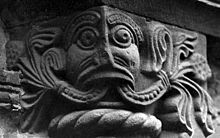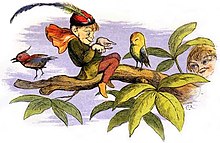
Back تراث شعبي إنجليزي Arabic Английски фолклор Bulgarian ইংরেজি লোককাহিনি Bengali/Bangla Folklore anglais French Англиски фолклор Macedonian Английский фольклор Russian Inglis fowklair SCO
This article has multiple issues. Please help improve it or discuss these issues on the talk page. (Learn how and when to remove these template messages)
|


| Culture of England |
|---|
 |
| History |
| People |
| Languages |
| Mythology and folklore |
| Cuisine |
| Religion |
| Art |
| Literature |
English folklore consists of the myths and legends of England, including the English region's mythical creatures, traditional recipes, urban legends, proverbs, superstitions, and folktales. Its cultural history is rooted in Celtic, Christian, Nordic and Germanic folklore.[1]
During the Renaissance in the 16th century, England looked to more European texts to develop a national identity. English folklore has continued to differ according to region, although there are shared elements across the country.[2]
Its folktales include the traditional Robin Hood tales and the Brythonic-inspired Arthurian legend, and their stories often contained a moral imperative stemming from Christian values.[3] The folktales, characters and creatures are often derived from aspects of English experience, such as topography, architecture, real people, or real events.[4]
- ^ McDowall, Robert (26 September 2019). "English Folklore: What Cultural Values Does It Represent?". #FolkloreThursday. Archived from the original on 24 July 2021. Retrieved 30 December 2021.
- ^ Cheeseman, Matthew; Hart, Carina, eds. (2022). Folklore and nation in Britain and Ireland. New York. ISBN 978-1-003-00753-1. OCLC 1250431455.
{{cite book}}: CS1 maint: location missing publisher (link) - ^ Mingazova, Liailia; Sulteev, Rustem (2014). "Tatar and English Children's Folklore: Education in Folk Traditions". Western Folklore. 73: 410–431 – via ProQuest.
- ^ Simpson, Jacqueline (2008). "Seeking the Lore of the Land". Folklore. 119 (2): 131–141. doi:10.1080/00155870802056936. S2CID 162117834.
© MMXXIII Rich X Search. We shall prevail. All rights reserved. Rich X Search